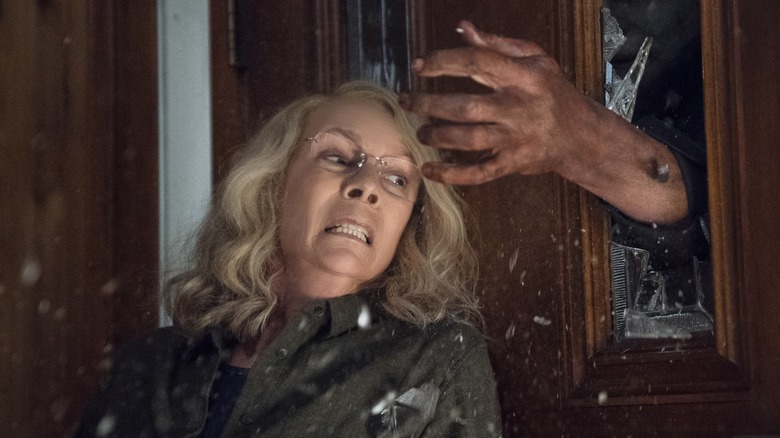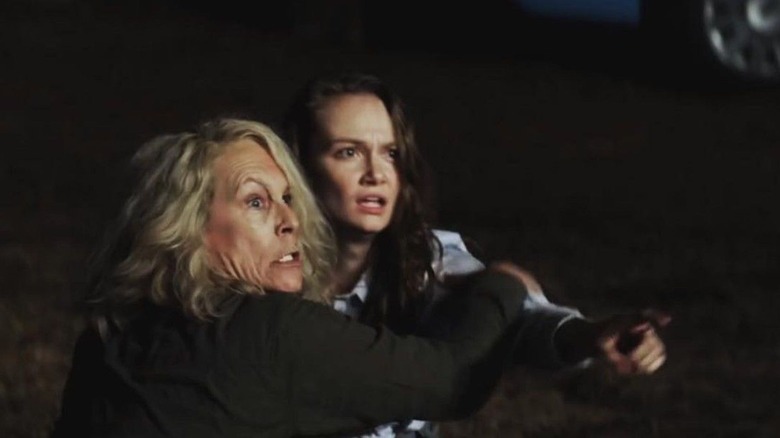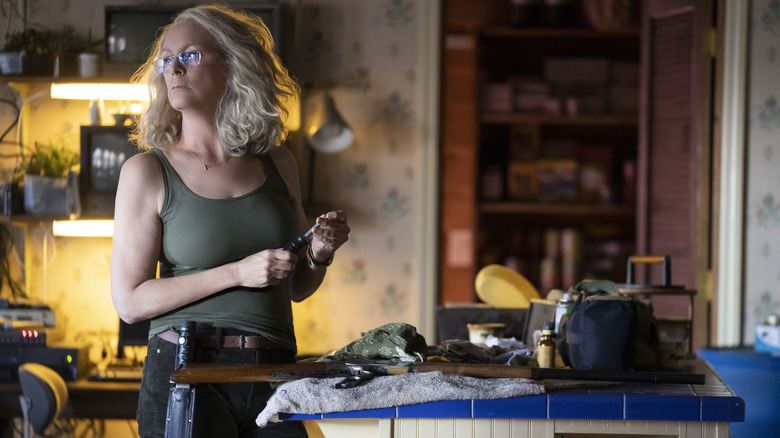The Original Halloween 2018 Script Featured A Very Different Laurie Strode
We may receive a commission on purchases made from links.
The "Halloween" franchise has been through it. John Carpenter's masterful 1978 original essentially launched the slasher craze, but the filmmaker had little creative interest in mapping out a horror franchise. He wanted to use his 1980s box office clout to make increasingly ambitious movies in all manner of fantastic genres. Still, there was simply too much money to be made off his low-budget triumph, so he reluctantly participated in its exploitation as a producer and, for a couple of films at least, story generator.
And when audiences rejected his (brilliant) non-Michael Myers installment, "Halloween III: Season of the Witch," he checked out entirely, allowing the producers to mine the white-masked fiend for a series of quick-and-progressively-silly cash-ins.
After a failed attempt at building a Druidic lore around Michael (while turning Danielle Harris' young Jamie Lloyd into a potential slasher heir apparent), the series was rebooted twice — once with the involvement of "Scream" creator Kevin Williamson ("Halloween H20: 20 Years Later") and later under the bizarro aegis of Rob Zombie. The problem with all of these efforts was their eschewal of the simple, seemingly unstoppable menace of Michael. We didn't need a backstory for this monster; we just needed the monster.
David Gordon Green's 2018 reboot "Halloween" understood this. Rather than dive back into the sibling connection between Michael and Laurie Strode (Jamie Lee Curtis), the filmmaker wiped the slate clean and made a direct sequel to Carpenter's first movie. In doing so, he was able to restore Michael's "blank, pale, emotionless" persona of pure evil while reimagining Curtis' iconic final girl as a dogged survivor. We know how it turned out, but Green's initial plan for Laurie was quite different from where he ended up.
A different flavor of Strode family dysfunction
According to an interview with co-producer Ryan Turek in Abbie Bernstein's book "Halloween: The Official Making of Halloween, Halloween Kills and Halloween Ends," the notion of Laurie as an unstable, hard-drinking survivalist who's pushed away her daughter Karen (Judy Greer) and maintains a distant relationship with her granddaughter Allyson (Andi Matichak) had yet to come into focus. Per Turek:
"Laurie was married and lived with her granddaughter, because her daughter Jamie was a hot mess. You had Laurie as the Grandma Grizzly Bear, protecting her granddaughter, and then drug addict Jamie intervenes, getting her s*** together in an effort to save her daughter."
This was probably more in line with what fans of the franchise expected. If Green's intention was to go in the extreme opposite direction of 1981's "Halloween II," his best bet was to erase the memory of Laurie as a tranquilized victim staggering around a hospital as Michael picks off the facility's skeleton crew. As an unabashed Greer fan, I would've loved to see the actress play a more complicated Karen (apparently named "Jamie" in this early draft).
But as Green and his screenwriting collaborators Danny McBride and Jeff Fradley further pondered their portrayal of three generations of Strode women, they decided Laurie should be the anxiety-stricken recluse. "But it was still this movie about three women," Turek said in the book, "and how Michael Myers has messed up their lives."
The evolution of the final girl
If there's a slightly disappointing element to Green's Laurie, it's that she feels like a riff on Linda Hamilton's chain-smoking, gun-toting Sarah Connor in James Cameron's "Terminator 2: Judgment Day." They both had their children taken from them, and, against all odds, pull it together when the killing machines that ruined their lives resurface.
That said, both Curtis and Hamilton give magnificent performances that, along with Sigourney Weaver's no-nonsense take on Ripley in Cameron's "Aliens," challenge our perceptions of final girls. The gulf between Laurie and Sarah between movies is especially jarring. One was an awkward, bookish teenager, while the other was a diner waitress with no ambition beyond landing Mr. Right. They're archetypes devoid of real emotional depth — which is fine because these movies are models of efficiency.
So it's cool that two male directors felt duty-bound to do these women justice, and not in a one-dimensional "Yas Queen" manner. These characters came out on the other side profoundly f***ed up, but, when their monsters return, they're ready to rumble. We don't all possess this kind of strength, but, when we throw on a genre flick, we want to see people who do.


